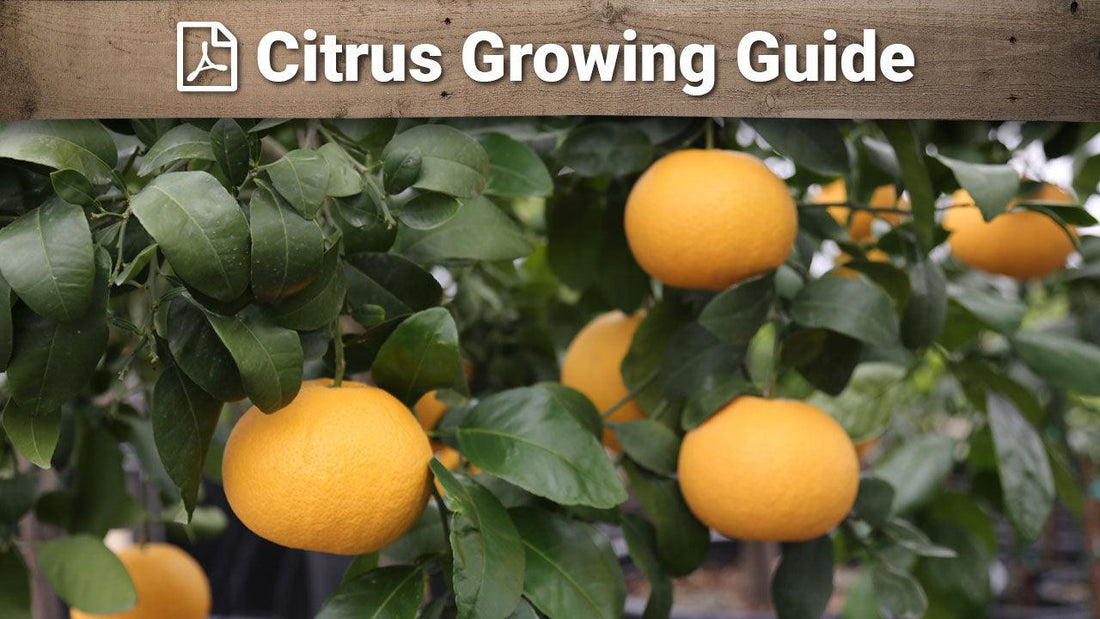Citrus trees, with their evergreen foliage, fragrant flowers, and vitamin C-rich fruits, are a valuable addition to any home garden. Whether you’re growing lemons, limes, oranges, or mandarins, understanding their care needs will help you enjoy a bountiful harvest. This guide covers everything from planting and watering to fertilizing, pruning, and frost protection.
Click here to access the complete Citrus Growing Guide (PDF) for detailed information on soil preparation, planting, and long-term care.
Best Growing Conditions for Citrus Trees
Citrus trees thrive in warm, sunny climates but can be grown in containers indoors if properly cared for. Here’s what they need:
• Sunlight: Full sun, at least 6–8 hours per day.
• Soil: Well-drained, slightly acidic to neutral (pH 6.0–7.0).
• Temperature: Most citrus are cold-sensitive, with hardiness varying by type:
- Limes & Lemons: Most tender, damaged below 32°F.
- Oranges & Mandarins: Tolerate temperatures down to 26–28°F.
- Satsuma Mandarins & Kumquats: Most cold-hardy, can survive down to 18°F.
Planting Citrus Trees
Acclimating Your Tree:
• Place in indirect sunlight for the first week, then gradually increase sun exposure.
• If temperatures drop below 40°F, bring container-grown trees indoors.
Planting Instructions:
• Timing: Plant early in the morning.
• Digging: Dig a hole twice the width of the root ball.
• Soil Mix: Backfill with native soil mixed with organic compost or a soil conditioner.
• Raised Beds: Use raised beds if you have poor drainage.
• Container Growing: Use a pot at least 1.5 ft in diameter with proper drainage.
Watering and Fertilizing Citrus Trees
Watering Guidelines:
• Ground-planted trees: Water deeply but infrequently to keep soil moist (not soggy). Apply a 2–3” mulch layer around the base, but keep it away from the trunk.
• Potted citrus: Allow the top inch of soil to dry between waterings. Ensure pots drain well to avoid waterlogging.
Fertilization Tips:
• When to fertilize: Apply an organic, nitrogen-rich fertilizer in early spring.
• How to apply: Mix into the top 6” of soil, extending to the drip line.
• Micronutrients: Provide zinc, iron, manganese, and magnesium, especially for container-grown trees.
• Calcium & potassium: Improve fruit quality with periodic soil testing to maintain nutrient balance.
For best results, choose high-quality fertilizers and soil amendments that support citrus tree growth throughout the season. Explore our wide selection of Fertilizers & Growing Supplies to find organic nutrients, soil conditioners, and micronutrient blends specifically suited for fruit trees and container gardening.
Frost Protection for Citrus Trees
Citrus trees are sensitive to frost damage. Protect them during cold snaps:
• Use row covers or frost blankets.
• Bring potted trees indoors or place them in a heated greenhouse.
• Mulch around roots to retain warmth.
• Water before frost, as moist soil retains heat better than dry soil.
Pruning Citrus Trees
Citrus trees require minimal pruning:
• Remove only dead or broken branches.
• Thin out suckers from younger trees.
• Lemon trees: Prune vigorously growing branches.
Harvesting Citrus Fruit
• First fruits: Expect fruit in the third or fourth year.
• Ripening time: Varies by climate—hotter climates produce earlier harvests.
• When to pick: Don’t rely on color—taste is the best indicator.
• Storage: Store freshly picked fruit at room temperature for up to one week or refrigerate for longer storage.
Common Pests and Problems
Pests:
• Aphids: Control with neem oil or insecticidal soap.
• Citrus leaf miner: Prune affected leaves or apply organic treatments.
• Root rot: Prevent by ensuring well-drained soil and avoiding overwatering.
Troubleshooting:
• Yellowing leaves: Check for overwatering or nutrient deficiencies.
• Fruit drop: May be caused by temperature fluctuations or insufficient pollination.
Why Grow Citrus Trees?
• Fresh organic fruit: Rich in vitamin C, great for juicing and cooking.
• Fragrant blooms: Adds beauty and scent to your garden.
• Year-round greenery: Beautiful evergreen foliage.
• Container-friendly: Suitable for patios and small spaces.

